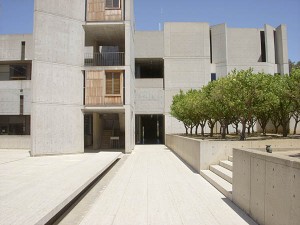From my desk at work it’s less than a fifteen minute stroll to this viewpoint, which has got to be one of the most famous places to stand in all of modern architecture.
The view is of the central plaza of the Salk Institute of Biological Studies, which architect Louis Kahn designed for his client, polio vaccine pioneer Jonas Salk. The plaza features this simple water feature that pulls your eye towards the water, 400 feet below, and to the horizon and the sky. The materials of the plaza are reduced down to water, travertine marble and the angled concrete walls of the research buildings.
No plants. When Kahn was working on the design he’d had a conversation with Mexican architect Luis Barragán. Kenneth Frampton recounts Barragán’s seminal response in Studies in Tectonic Culture: The Poetics of Construction in Nineteenth and Twentieth Century Architecture:
“I would not put a tree or blade of grass in this space. This should be a plaza of stone, not a garden.” I [Kahn] looked at Dr. Salk and he at me and we both felt this was deeply right. Feeling our approval, he added joyously, “If you make this a plaza, you will gain a facade–a facade to the sky.”
As much as I love plants, I have to agree that this was the right decision. There’s an unphotographably joyous experience of pure space that settles into your mind as you stand or sit to contemplate the view.
If you can pull your eyes off the horizon–not an easy thing to do–you start to notice, however, that plants do figure in the plaza’s final realization. Immediately to the east are some steps, and planting beds on either side of the steps. As with a lot of modern planting design, the planters feature one kind of plant and one kind only. Considering the planting design was executed many years ago, probably in the late 1960s or early 1970s, long before the current focus on edible landscaping, it’s surprising that the plant of choice was orange trees, at least four dozen of them. (Maybe it has something to do with the environmental ethic that was developing while the Salk was being designed, an ethic that we’re finally rediscovering today.)
Below is a 360-degree panorama from the top of the steps. Just imagine walking west towards the horizon, at dusk, on a calm evening, as the orange trees begin to flower and scent the air.


